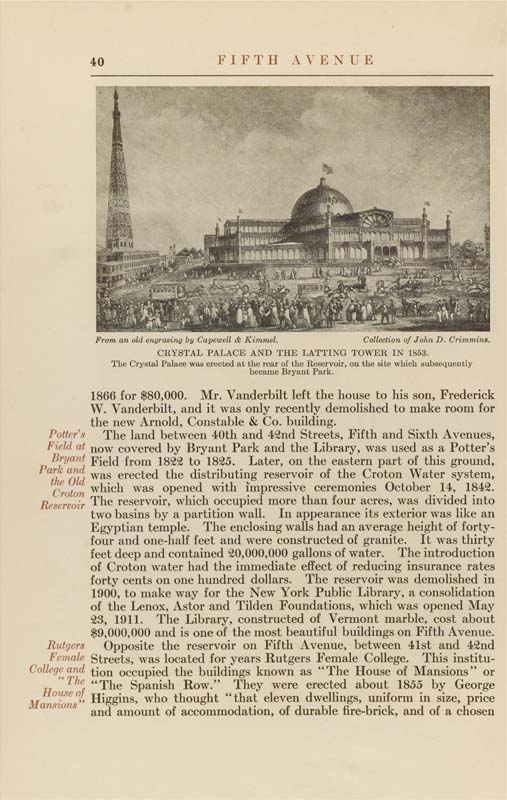40
FIFTH AVENUE
Potter's
Field at
Bryant
Park and
the Old
Croton
Reservoir
Rutgers
Female
College and
"The
House of
Mansions**
From an old engraving by Capewell & Kimmel. Collection of John D. Crimmins.
CRYSTAL PALACE AND THE LATTING TOWER IN 1853.
The Crystal Palace was erected at the rear of the Reservoir, on the site which subsequently
became Bryant Park.
1866 for $80,000. Mr. Vanderbilt left the house to his son, Frederick
W. Vanderbilt, and it was only recently demolished to make room for
the new Arnold, Constable & Co. building.
The land between 40th and 42nd Streets, Fifth and Sixth Avenues,
now covered by Bryant Park and the Library, was used as a Potter's
Field from 1822 to 1825. Later, on the eastern part of this ground,
was erected the distributing reservoir of the Croton Water system,
which was opened with impressive ceremonies October 14, 1842.
The reservoir, which occupied more than four acres, was divided into
two basins by a partition wall. In appearance its exterior was like an
Egyptian temple. The enclosing walls had an average height of forty-
four and one-half feet and were constructed of granite. It was thirty
feet deep and contained 20,000,000 gallons of water. The introduction
of Croton water had the immediate effect of reducing insurance rates
forty cents on one hundred dollars. The reservoir was demolished in
1900, to make way for the New York Public Library, a consolidation
of the Lenox, Astor and Tilden Foundations, which was opened May
23, 1911. The Library, constructed of Vermont marble, cost about
$9,000,000 and is one of the most beautiful buildings on Fifth Avenue.
Opposite the reservoir on Fifth Avenue, between 41st and 42nd
Streets, was located for years Rutgers Female College. This institu¬
tion occupied the buildings known as "The House of Mansions" or
"The Spanish Row." They were erected about 1855 by George
Higgins, who thought "that eleven dwellings, uniform in size, price
and amount of accommodation, of durable fire-brick, and of a chosen
|








